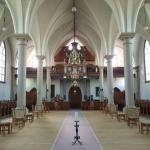
In brief
Everyone knows them, the dozens of remains of parts of the former Atlantic Wall (defense line) in the dunes and along the coast.
Sometimes these are large complex underground buildings (bunkers) that exist freely in or just below the landscape and sometimes they are buildings that dominate the immediate surroundings.
In other cases, these are small bunkers hidden by time and nature and no longer accessible because they are largely filled with sand or are in the middle of a forest and hardly anyone still suspects their existence. Soon they will have disappeared completely under the sand, as has happened to so many bunkers.
This V.F. 7a type ammunition bunker opened in 2016 as the Jansje Schong Bunker Museum. The bunker has been completely refurbished again, making it easily accessible. The museum consists of two rooms.
Collection at the Bunker Museum
In the collection you will find some rare pieces such as:
- A signed Mein Kampf
- A plate from Hitler’s Reichs Kanzlei
- The chair with a story attached
- Unique parts of the Dam Busters A for Apple which crashed in Castricum and we found the remains in 2017.
- A collection of number-identical bayonets
- Part of a window shutter from Hitler’s Berghof showing the burned wood and piece of melted camouflage net
- Original barricades of Egmond beach.
- In the film room, a moving film about post-war mine clearance by young German conscripts showing remnants of the mines they removed.
Video Bunker Museum Egmond
The story of Jansje Schong
All residents of Egmond aan Zee were evacuated during World War II.
Nearby Heiloo offered shelter to many people, but danger prevailed there as well.
A fatal accident struck the Egmond family Schong, with disastrous consequences.
Watch the video for the full story.
History of the bunker
Daylight after 67 years
It was Piet Zwart from Egmond aan Zee. He was one of the people who, by order of the Bureau Registratie Verdedigingswerken (BRV), had to close off and bricked up all the defense works such as the bunkers on the north side of Egmond aan Zee on then shoveling a thick layer of sand over them.
It was now more than two years after the end of the war and Egmond aan Zee was slowly but steadily recovering from the War.
“Forget about that mess,” was the motto; we have better things to do than to have to send the youth away from those “bunkers” every time.
It was hot that Tuesday, Aug. 5, he had already had several and this was the last one today. This was a former ammunition bunker, one with two large rooms and a long gallery in front of it which was connected to other bunkers. This allowed the soldiers to remove ammunition from the ammunition bunker relatively safely in the event of an attack without the danger of still being shot at.
One side of the bunker was already bricked up by now, Pete was getting his stuff ready to bricked up the other side too, when he thought of putting his signature on the wall: he grabbed his carpenter’s pencil and wrote on the wall :
“P. Zwart , Trompstraat 5 , Egmond aan Zee , 5-08-1947”
Then he drew about three more ships on the wall before bricking up the bunker for good… he thought….

“P. Zwart , Trompstraat 5 , Egmond aan Zee , 5-08-1947”

July 2014,
Slowly, the excavator makes its way through the soft dune soil. Debris and sand has been dug away for half an hour now. It’s warm that day in July. Around the pit people from the Egmond ’40-’45 Foundation, volunteers and people from the Hague bunker crew. At their direction, the foundation found this bunker. An ideal place for a museum about the ’40-’45 period.

The excavator now comes to a bricked-up entrance… Now a passage through the wall must be made. With the help of a jackhammer and a generator, light is slowly coming after 67 years of darkness….
After the entrance is large enough to pass through, Martijn goes in first: Gutentag…? no response…
After some laughter, the others follow. The bunker is being explored and found safe for further investigation. One of the two former ammunition rooms can be entered; the other is barred by debris. However, the barred space can be closely viewed through an air shaft; it too appears to be in perfect condition. After spending about two hours in the bunker, we continue our investigation:
What condition are the attached tunnels in?
After sealing the bunker, another 3 meters of sand is pushed up. Now it’s the tunnels’ turn. Of these, however, only the side walls appear to remain standing; the roofs have been demolished. As the day draws to a close, the dune area is given back to nature: sand is pushed back onto the tunnels and marram grass is planted back.
For us, this day is a success: the Egmond ’40-’45 Foundation took step 1: viewing the bunker and its adjacent corridor systems.
Final result
The complete bunker appears to be in perfect condition including Pete’s drawings. However, the tunnels appear to have been demolished.
We will now plan with Water Board where the sand around and on the bunker should go so we can create a safe entrance and exit.
And as is well known by now. Is the bunker after much digging and restoration work for you to go back in time and experience what it must have been like then.
Video Bunker Excavation
Cultural ANBI
As of 2018, we as Egmond ’40-’45 Foundation and thus Bunkermuseum Jansje Schong have a Cultural ANBI Status.
Donors to cultural ANBIs have an additional tax advantage, as an additional gift deduction applies to them.
Individuals may deduct 1.25 times the amount of the gift in their income tax return. Companies subject to corporate income tax may deduct 1.5 times the amount of the gift in their corporate income tax return.
Rates
From 12 years of age €2.50 Per Person.
Accompanied children under 12 years of age free.
Donors have free admission. You can pay by PIN with us.









